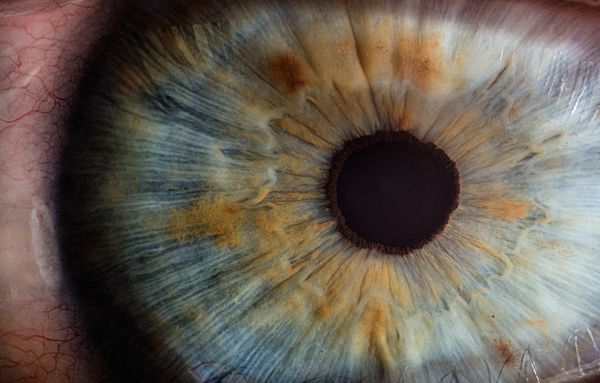Age-related macular degeneration (AMD) is common among people aged 50 and older. According to the American Academy of Ophthalmology, about 10% of people aged 50 to 64 have some form of AMD, which increases to around 30% for people over 75.
Age-related macular degeneration (AMD) is a chronic eye condition that affects the macula, the retina's central portion responsible for sharp, central vision. AMD is a leading cause of vision loss among people aged 50 years or older.
There are two types of AMD:
- Dry AMD
- Wet AMD.
Dry AMD is more common and progresses slowly over time. It is characterized by the accumulation of yellowish deposits called drusen in the macula, which can cause gradual vision loss. Wet AMD is less common but more severe and can cause rapid vision loss. It is characterized by the growth of abnormal blood vessels in the macula, which can leak blood and fluid and cause scarring.

AMD can cause a range of symptoms, including:
- Blurred vision: This is often the first symptom of AMD. Objects may appear blurry or hazy, and fine details may be difficult to see.
- Distorted vision: Straight lines may appear wavy or crooked, and objects may appear in different shapes or sizes.
- Reduced central vision: AMD primarily affects the macula, which is responsible for central vision. The central vision may become increasingly blurry or dark as the condition progresses.
- Difficulty reading: Words may appear blurry or distorted, and it may be difficult to read the small print.
- Difficulty recognizing faces: People with AMD may struggle to recognize faces or distinguish between similar objects.
- Decreased contrast sensitivity: Colors may appear less vivid, and it may be more difficult to distinguish between shades of the same color.
It's important to note that not all people with AMD will experience all of these symptoms, and the severity of the symptoms can vary depending on the type and stage of AMD.
The exact etiology of age-related macular degeneration (AMD) is not fully understood. Still, it is believed to be a combination of genetic, environmental, and lifestyle factors. Some of the known risk factors for AMD include:
- Age: AMD is more common in people over 50.
- Genetics: A family history of AMD is a significant risk factor. Certain genetic variations, such as the complement factor H (CFH) gene, have been associated with an increased risk of AMD.
- Smoking: Smoking is a significant risk factor for AMD, and the risk increases with the number of cigarettes smoked daily.
- Diet: A diet high in saturated and trans fats and low in antioxidants and omega-3 fatty acids may increase the risk of AMD.
- Cardiovascular disease: High blood pressure, high cholesterol, and other cardiovascular risk factors may increase the risk of AMD.
- Light exposure: Long-term exposure to blue light and UV light may contribute to the development of AMD.
- Obesity: Obesity may increase the risk of AMD.
This eye condition is typically diagnosed through a comprehensive eye exam, which may include the following:
- Visual acuity test: This measures how well you can see at a distance.
- Dilated eye exam: Your eye doctor will examine the inside of your eye using special instruments to look for signs of AMD, such as drusen or abnormal blood vessels.
- Amsler grid test: This simple test involves looking at a grid of lines to check for any distortion or missing areas in your central vision.
- Optical coherence tomography (OCT): This non-invasive imaging test uses light waves to create detailed images of the retina. OCT can help detect signs of AMD, such as fluid or swelling in the macula.
- Fluorescein angiography: This imaging test involves injecting a special dye into your arm and taking pictures of your eye as the dye passes through the blood vessels in your retina. This can help detect abnormal blood vessels that may be causing wet AMD.
If AMD is diagnosed, the eye doctor may recommend regular follow-up exams to monitor the progression of the disease and determine if treatment is necessary.
The treatment for age-related macular degeneration (AMD) depends on the type and severity of the condition. There are currently no treatments for dry AMD, but some options are available for wet AMD that can help slow down its progression and preserve vision. These include:
- Anti-VEGF therapy: This involves injecting a medication into the eye that can block the growth of abnormal blood vessels in the macula. This treatment can prevent further vision loss and may even improve vision.
- Photodynamic therapy: This involves injecting a light-activated drug into the arm and then shining a laser into the eye to activate the drug and destroy the abnormal blood vessels in the macula.
- Laser photocoagulation: This involves using a laser to seal leaking blood vessels in the macula.
- Low vision aids: These are devices such as magnifiers, telescopes, or special glasses that can help people with AMD make the most of their remaining vision.
It's important to note that these treatments do not cure AMD and may not work for everyone. Early detection and regular eye exams are key to managing AMD and preventing vision loss. Maintaining a healthy lifestyle, such as not smoking and eating a balanced diet, may also help reduce the risk of AMD and slow its progression.
(AMD) can lead to several complications significantly affecting vision and quality of life. Some of these complications may include the following:
- Blindness: AMD is one of the leading causes of blindness in older adults, particularly those over the age of 65.
- Central vision loss: As AMD progresses, it can cause a loss of central vision, making it difficult to perform everyday tasks such as reading, driving, and recognizing faces.
- Depression and anxiety: The loss of vision and independence resulting from AMD can lead to feelings of depression, anxiety, and social isolation.
- Increased risk of falls and accidents: AMD can make it difficult to see obstacles and hazards, increasing the risk of falls and accidents.
- Reduced quality of life: AMD can significantly reduce a person's quality of life, impacting their ability to work, engage in hobbies, and enjoy everyday activities.


